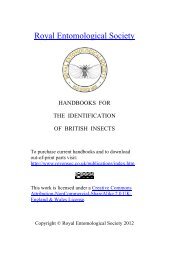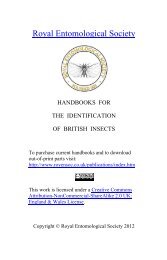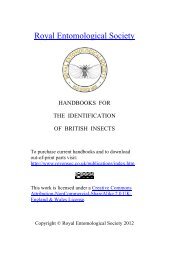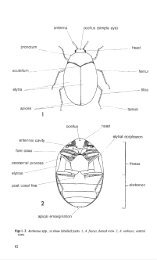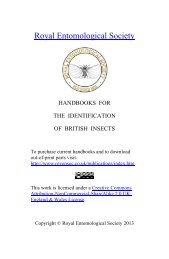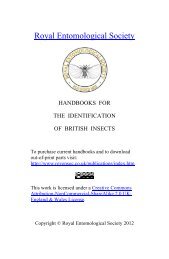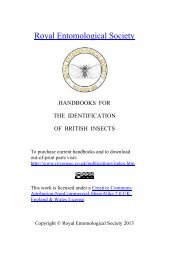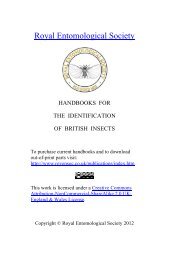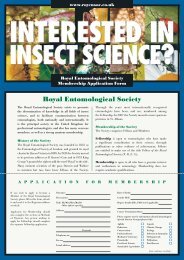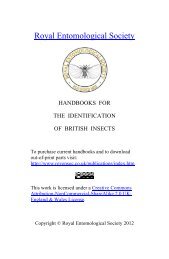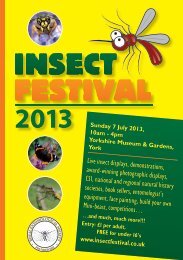Vol 5 Part 12. Coleoptera. Cerambycidae. - Royal Entomological ...
Vol 5 Part 12. Coleoptera. Cerambycidae. - Royal Entomological ...
Vol 5 Part 12. Coleoptera. Cerambycidae. - Royal Entomological ...
- No tags were found...
You also want an ePaper? Increase the reach of your titles
YUMPU automatically turns print PDFs into web optimized ePapers that Google loves.
CERAMBYCI NAE 9Arhopalus (= Criocephalus).Eyes with numerous short setae. Third tarsal segment divided almost to base(fig. 13a). Length 12-16 mm. Northern species ......... .. . A. rusticus (Linnaeus).Eyes without setae.Length 13-26 mm.Third tarsal segment much less strongly divided (fig. 13b).Southern species ...... ... ... ...... ............ ... A. ferus (Mulsant).Tetropium.I Disc of thorax smooth, shining and finely punctured. Elytra black. Length10-15 mm .... ... ... .................. ...... ... ......... ......... ......... ... T. gabrieli Weise.Disc of thorax rugose, dull and coarsely punctured. Elytra reddish-brown.Length 10- 14 mm ....... ... ........................ ... ... ... .. ....* T. fuscum Fabricius.4. CERAMBYCINAE.I Elytra much shorter than abdomen, the latter at least partly covered by theextended wings ... ......... ............... ......... ... .................. ...... ... .. . ... ... ... ... 2.Elytra completely covering abdomen except sometimes the pygidium ...... .. ....... 3.2 Eyes oval. Thorax quadrate. Front and middle femora clavate and bearing afew short, silky setae. Length 3- 5 mm. Usually from wickerwork.Leptideella brevipennis (Mulsant).- Eyes comma-shaped, their inner margins strongly emarginate. Thorax elongate.Front and middle femora pet iolate apically and bearing numerous long bristlysetae (fig. 14) ...... ... ...... .. . ... ... ... ............ ............ .. .......... Molorchus (p. 12).3 Thorax with a conspicuous pair of lateral or dorso-lateral spines or tubercles.Length at least 20 mm . ............ .. .......... ... ............... ............... ...... ... ......4.Thorax without lateral spines or tubercles. L ength usually much less ...... ...... 9.4 Elytra metallic green, blue or copper ............ ... ........................... ............... 5.Elytra dull black, brown, or blue ...... ................................................... ...... 7.5 Antennae serrate or pectinate. Elytra each with an apical tooth or spine (fig. I 5) .Legs and antennae red or black. African species ...... ... .. ................... ...... ... 6.Antennae simple and filiform. Elytra without apical teeth or spines. L egs andantennae greenish-blue. L ength 20-32 mm. Chiefly from SalixAromia moschata (Linnaeus).6. F emora strongly petiolate (as in Molorchus, fig. 14). Antennae strongly pectinate.Elytra tapering posteriorly and each bearing an apical spine (fig. l5b). Chieflyfrom Khaya ... .................. .. ............. .................. ... ...* Cordylomera (p. 12).Femora not petiolate. Antennae serrate. Elytra parallel-sided and truncateand dentate apically (fig. 15a). Chiefly from Aucoumea and Khaya* Plocaederus (p. 12) .7 Elytra pale blue, with black transverse bands and spots. Antennae b lue, withapices of segments bearing conspicuous tufts of black hairs. Length 20- 32 mm.Chiefly from F agus ............ .. . ............ .. .............* Rosalia alpina (Linnaeus).E lytra brown or black. .-\ntennae brown or black and without tufts of blackhairs .. ....... ...... .. ................... ...... ................................................ ... ... 8.8 Elytra with apices each produced into a single short sutural spine or evenly rounded ;dark brown or black, shining and without markings. Thorax coarsely transverselyrugose ; disc without a pair of tubercles. European species. Fromdeciduous trees ...... ..................... ... .. . .. ....... ............(*) Cerambyx (p. 12).Elytra with apices each produced into a pair of long spines (one on sutural angle,the other on outer angle) (fig. 16); light brown, with two pairs of paired, shining,white, elongate spots, one pair at base, the other just beyond middle.Thoraxdensely punctured and disc with a pair of paramedian dark brown tubercles.L ength 18-26 mm. North American species. Frequently from oak furniture,from which it emerges often several years after the timber has been utilised.* Eburia quadrigeminata Say.,9 Apices of elytra produced into one pair of conspicuous spines (fig. 17). Elytranever with yellow design ......... ......... ... .. .......... ... .................. ............... 10.Apices of elytra without apical spines (except Clytini pars, but then elytra with ayellow design) .................. ......... .............................. ........................ <strong>12.</strong>10 Elytra with sutural angle produced apically into a single stout spine. Elytrashining and very strongly punctured. Length 16- 30 mm. Oriental species.From seasoned timbers of many kinds ; often in plywood packing-cases* Stromatium barbatum Fabricius




